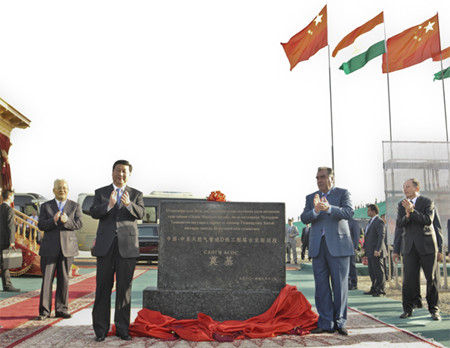
On 13th September, Chinese Chairman Xi Jinping and Tajikistan President Rakhmon jontly attended the ceremonies of several major cooperation projects between China and Tajkistan. The ceremonies includes completion ceremony of Dushanbe No.1 thermal power plant project, groundbreaking ceremony of Dushanbe No.2 thermal power plant project and groundbreaking ceremony of China-Asia d gas pipeline in Tajikistan.
The d line is a major project demonstrates China’s energy cooperation with Central Asian countries. The source of gas is located in Turkmenistan. The gas is planed to flow through Uzbekistan, Tajikistan and Kyrgyzstan and finally enter into China. The project is expected to be finished in 2016, with an annual throughout of 30 billion cubic meters. The pipeline is totally 1,000 kilometers long. It is a cooperation project between China National Petroleum Corporation and countries along the line. There are nearly 410 kilometers of line in Tajikistan.
Construction of this line is faced with unprecedented difficulties. Pipelines in this line will suffer from high pressure, with large capacity of gas transmission. The line will pass complex terrain and varied topography. It will run across 47 big or small rivers, 45 mountain tunnels and river tunnels. The tunnels are 76 kilometers long. As to the line in Tajikistan, there are about 60% of pipelines go through seismic region of high intensity. The d line will go via Tajikistan and Kyrgyzstan for the first time. Therefore, it will form the China-Central Asia gas pipelines net together with a line, b line and c line.
The d gas line begins from the Renaissance field in Turkmenistan and stops at Ulugqat, Sinkiang. It is analyzed that this can not only benefit national energy security, but also push the infrastructure of south Sinkiang.
The total investment volume of d line is nearly 6.7 billion USD. Expenses of taxation during construction and operation period will achieve 3.1 billion USD. This line will produce tens of thousands of job opportunities. As a critical part of Energy Channel – Silk Road Economic Region, the China-Central Asia gas transportation pipelines will be able to transport 85 billion cubic meters per year. Thus, it will become the biggest gas transmission network in Central Asian. The a, b and c lines of Central Asia gas pipelines have accumulated transmitted over 95 billion cubic meters of gas.







0 comments:
Post a Comment